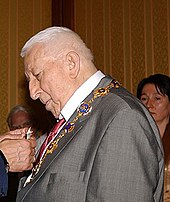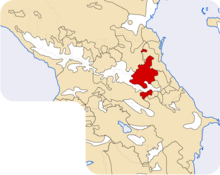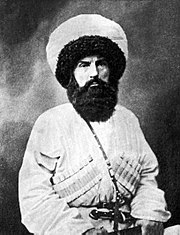Avars (Caucasus)
The Avars , also called New Avars , (own names Awaral and Ma'arulal , "Avars", "mountain people") are a people in the Caucasus that includes around one million people. In the Russian Republic of Dagestan they make up the largest and most influential population group with 28%. They live mainly in the south-western, mountainous part of the country. A minority live in northwest Azerbaijan and about 20 settlements are in Turkey .
The Avars have been Sunni Muslims ( Shafiite ) since about the 11th to the 16th centuries and were previously mostly Christian Orthodox.
The Aware Imam Shamil , who led a long-standing uprising against the Russian occupation in the 19th century, became known.
population
According to the 2010 Russian census, there were 850,011 Avars living in Dagestan and 48,184 people who named themselves after languages close to the Avars. In 2010 there were 912,090 Avars and 48,646 people in Russia who named themselves after related languages. The census in Azerbaijan found around 50,900 Avars in Azerbaijan, where they form the largest ethnic groups in the districts of Zaqatala (51%) and Balakän (48%). There are several thousand more Avars in Turkey and other countries.
Language and writing

The language of the Avars, the Avar and belongs to the branch of Ando-Awaro-Didoischen languages within the language family of the Northeast Caucasian languages in the language complex of the Caucasian languages .
In the Middle Ages it was occasionally written in Georgian script, and after Islamization in Arabic script. An alphabet in Latin script was developed in the 1920s, which was replaced by a Cyrillic alphabet in 1938.
Awaral and Avars
Whether this people had a relationship with the historical cavalry people of the Avars , or whether their names were accidentally identical, has not yet been fully clarified. However, several sources indicate that the Avars in the Caucasus and the steppe peoples were allied powers in the early medieval period and the Avars in Dagestan were allies of the steppe peoples. The historical center of the Avars is "Chunsach". The Avar word “Awarag” means “prophet, messenger, messiah”, while the similar Turkish word Avar (“wanderer”, “vagabond”) is of Iranian origin.
Surname
The Arabic name of the first Avar state (from the 6th to the 13th century) was Ard as-Sarir . According to the reports of the Arab geographer and traveler Ahmad ibn Rustah (10th century), this country was ruled by a Christian ruler by the name of "Auhar" (or "Awhar"). It is believed that “Sarir - Awaria” was the Christian country in the Northeast Caucasus.
history
The Avars initially lived in the east of a group of linguistically related mountain peoples of Ando-Avaro-Didoic languages in the mountainous west of Dagestan, who founded tribal empires. Georgian sources from the Middle Ages mention the Avars as well as the Hunsibians and Didoer (Tseses), two tribal groups of Didoic languages as separate peoples in the neighborhood. The Avar rulers bore the title of Nuzal . From around 500 AD, the country is first mentioned in Georgian sources as an ally of the Alans in the Caucasus (today's Ossetians ) and Christianized in the following years. Muslim sources of the 10th and 11th centuries, including al-Masudi and al-Istachri, still described Sarir as a Christian country. Around 900 it experienced its first heyday under Nuzal Filan-Shah, but around 680 it came under the suzerainty of the Khazars and after the collapse of this empire in the 10th century under the suzerainty of the Islamic caliphate and later the regional Muslim rulers of Derbent and Shirvan and the Cumans . In the following period, from 11th to 16th In the 19th century, the Avars and other groups in the region converted to Islam. As is often the case in the North Caucasus, traveling preachers of Sufism played a role in Islamization . After the Mongol invasions in the 13th century, the country under Nutzal Emir Chunzak (1256-1306) became the dominant power of Dagestan, but was defeated after 1400 by the rulers of the Kumyks .
The Avar Khanate
At the end of the 15th century the state emerged as "Nuzal-Chanat" around the main town of Tanush and, 100 years later, in an alliance with other Dagestan peoples, eliminated the Kumyks' sovereignty over Dagestan. The border wars between the Ottoman Empire and the Persian Safavid Empire , which also included Dagestan, took advantage of the Avar chans and in the 17th century, under Persian suzerainty, made itself the leading power of the Dagestan mountainous country. Umma I. Chan (d. 1634, change of the name "Umar") codified the Avar customary law . The unrest after the fall of the Safavid Empire survived the Avar Nutzale with varying fortunes of war. Umma II. Khan (d. 1735) had to accept defeats against the Dargins and therefore in 1727 temporarily submitted to the protection of the Russian tsars. The attacks by Nadir Shah on Dagestan were again able to fend off the Dagestan mountain people together in 1742. Then first attacked the Lesgier and then the Avars under Machmud Nuzal (d. 1754) and ʿUmma-Chān III. the Azerbaijani and Georgian principalities. Under the rule of Umma-Chān III. the Avarian Khanate reached its climax, so that numerous regions as far as South Caucasia paid tribute to it.
Only a joint Russian-Georgian victory in 1799 ended the Avar campaigns to Transcaucasia, and in 1801 the Nuzal-Khans again submitted to the Russian protectorate. At the beginning of the 19th century, the royal house experienced a process of fragmentation, and the sphere of influence of the khanate shrank to the plain of Chunzach. As a reaction to the enforcement of unconditional obedience to the tsar, Sultan Ahmad Chān called for a defensive fight against Russia around 1820, which he declared as jihad . This led to the Russians occupying the area in 1821 and providing the Chan with a military advisor.
The Nakshbandi Imamate
A Sufi movement of the Naqschbandiyya , which in Russia was called Muridism (Russian: мюридизм), formed against the Russian colonization and the local princes who sometimes cooperated with them . Under the leadership of Imam Ghazi Muhammad (Russian Kazi-Mullah / Кази-Мулла, Imam 1827–1832), Dagestani mountain peoples defended themselves from around 1827 against Dagestani princes and Russia ( Caucasus War (1817–1864) ), Chechens and other North Caucasian people Peoples soon joined. The second Imam Hamzat Beg destroyed most of the members of the Nuzal family in 1834, but fell victim to the revenge of Hajji Murat that same year . The third Imam Shamil achieved some internationally acclaimed successes against the Russian army before he surrendered in 1859. All three Nakshbandi imams were Avars. A smaller part of the Avars emigrated to the Ottoman Empire. The temporary Avar predominance in Dagestan led to the spread of the Avar language, which partly pushed back other regional Ando-Avaro-Didoic languages. Naqschbandi Sufism is still very widespread in the region today.
An attempt by Ibrahim-Chan to reestablish the Nuzal-Chanat from Lesgier - Chanat Mechtulin between 1859 and 1863 failed because Russia sent him into exile.
After the Russian annexation
In April 1864 the khanat was finally abolished and the area was annexed by the Russians. In the Soviet Union the area became part of the ASSR Dagestan and after 1926 the speakers of this language group were combined to form the titular nation of the Avars, who only used the Avar language as written and school language, which increased linguistic assimilation. When the 2002 Russian census included the other languages for the first time since the 1926 census, they were either extinct or had between two and over 20,000 speakers. Avar is the most widely spoken language in Dagestan after Russian.
The Soviet literacy and industrialization efforts were relatively late in the traditionally very rural Dagestan - since the 1950s - successful. The Avars are practically completely literate and now some of them live in cities, especially in Makhachkala .
literature
German and English literature
- Wolfdieter Bihl : The Caucasus Policy of the Central Powers. Part 1: Your basis in Orient politics and your actions 1914–1917 . Böhlau, Vienna / Cologne / Graz 1975, ISBN 3-205-08564-7 , p. 31f.
- Hélène Carrère d'Encausse , Alexander Bennigsen: Avars . In: The Encyclopaedia of Islam. New Edition , Vol. I, pp. 755-756.
- Michael Kemper: Rule, Law and Islam in Daghestan. From the khanates and municipal alliances to the jihād state. Reichert, Wiesbaden 2005, ISBN 978-3-89500-414-8 .
- Otto Luchterhandt : Dagestan. Unstoppable collapse of a grown culture of interethnic balance? Hamburg 1999.
- Johannes Rau: Politics and Islam in the North Caucasus. Sketches about Chechnya, Dagestan and Adygea. Vienna 2002.
- Emanuel Sarkisyanz : History of the oriental peoples of Russia until 1917. Munich 1961, pp. 123-133.
- Gerhard Simon : Nationalism and nationality politics in the Soviet Union from dictatorship to post-Stalinist society. Baden-Baden 1986.
Russian literature
- ME Aleksejev, BM Atajev. Avarskij jazyk , Moscow 1998.
- M. Magomedov. Istorija avarcev . Makhachkala 2005.
- Lingvisticheskij enziklopedicheskij slovar ' . Moscow 1990.
- Alarodii (sbornik statej) . Makhatchkala 1995.
- SL Nikolajev, SA Starostin. A North Caucasian Etymological Dictionary . Moscow, 1994
- P. М. Debirov. Rez'ba po kamnju v Dagestane . «Nauka» Moscow 1966.
- A. Magomeddadaev. Emigracija dagestancev v Osmanskuju imperiju (Istorija i sovremennost ') . Makhatsckala 2001.
Web links
- The Avars, the Kumyks and the Tabasarans . Report from the radio station "Voice of Russia"
Individual evidence
- ↑ Results of the 2010 Russian Census. Excel table 7, line 432.
- ^ Results of the 2010 Census of Russia. Excel table 7, lines 433 to 445.
- ↑ Excel table 5, line 13.
- ↑ Excel table 5, lines 14 to 27.
- ↑ Article, 11th paragraph. In: Demoskop Weekly , 2004/05; Russian trade journal
- ↑ a b Hélène Carrère d'Encausse , Alexander Bennigsen: Avars . In: The Encyclopaedia of Islam. New Edition , Vol. I, p. 755
- ↑ a b Kemper, p. 34.
- ↑ Kemper, pp. 195-211.


